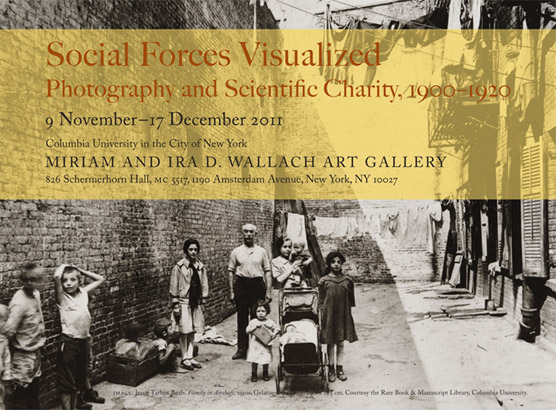Winter 2011
Wallach Art Gallery, Columbia University
Wall Street Journal
New Yorker
NY Photo Review
Social Forces Visualized offers an innovative view of the beginnings of social documentary photography in the United States. The exhibition includes over 125 photographs by seminal photographers Jacob Riis, Lewis Hine, Jessie Tarbox Beals, and others. The exhibition also includes a generous selection of original illustrations, maps, exhibition panels, and publications in which many of the photographs first appeared.
Since the 1930s, Jacob Riis and Lewis Hine have been established as the progenitors of the social documentary tradition in the United States. However, their most well-known images are almost always shown in isolation, without the publications, exhibition displays, and lantern-slide lectures in which they first appeared and circulated. This exhibition and the accompanying catalogue will place their photographs, along with those by other photographers, within the diverse and multi-media visual strategies employed by two charity organizations, the Charity Organization Society (COS) and the Association for Improving the Condition of the Poor (AICP), during the first two decades of the twentieth century.
Both the COS and the AICP, formed in 1882 and 1843, respectively, were part of the broad "scientific charity" movement, an approach to charity that involved not only assisting, but also studying the poor. At the turn of the twentieth century, with the proliferation of photography and new media coinciding with the rise of social work, the underlying strategies used by these organizations was evolving. From the late 1880s to the late 1910s, exactly the span covered by Social Forces Visualized, COS and AICP moved from purchasing photographs from various agencies to hiring individual photographers, such as Hine and Riis, for extended projects on topics as diverse as tenement housing, tuberculosis, food safety, and widow's pensions. These photographs functioned as a form of scientific data. COS and AICP hung them alongside graphs, dioramas, and electro-mechanical displays in exhibitions; published them as part of proto-sociological surveys, informational pamphlets, and advertisements; and projected them in lantern-slide shows.
Toward the end of the 1900s COS and the AICP sought to expand their publications and exhibitions' audience from professional social workers to a wider, lay public. In doing so, the organizations moved from using photographs as a form of data collection to relying on them to bolster emotive pleas for assistance—a practice utilized by thousands of charity organizations to his day.
Social Force Visualized from Columbia University News on Vimeo.
